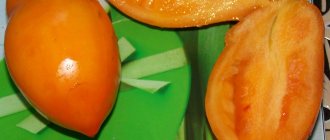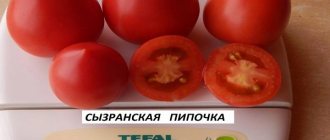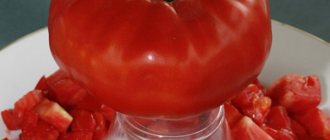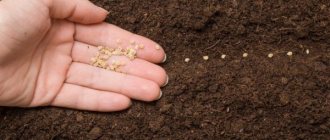Description of the tomato variety Pride of the Feast
The Pride of the Feast tomato is a first-generation hybrid (designation F1), bred in Russia in 2016 by breeder V. Blokin-Mechtalin (). The culture passed successful tests, and the very next year (2017) was included in the register of breeding achievements of the Russian Federation. Approved for cultivation in all regions in greenhouses and open ground.
Main characteristics:
- indeterminate (grows without restrictions);
- tall (150-180 cm);
- mid-early (fruits are formed in 90-100 days).
The bushes are tall, so they require staking to a support. The leaves are elongated, medium in size, rich green in color. The first inflorescence is formed above the 9th leaf. Each brush produces 3-5 tomatoes.
Description of fruits
The characteristics of the Pride of the Feast variety provide a photo and detailed description of the tomatoes. These are flat-round large fruits with a diameter of 7-10 cm. The average weight is 250-300 g, sometimes up to 400 g. The surface is a rich orange, scarlet color. A slight ribbing is noticeable in the area of the stalk.
The pulp of tomatoes is juicy, fleshy and moderately dense. The taste is very good, balanced, and is characterized as “excellent” in the register of breeding achievements. The skin is strong, so the tomatoes do not crack, which allows them to be transported over long distances and stored without loss of taste.
There are noticeably many nests with seeds on the cut - up to 10-12. There is no need to collect them, since full-fledged offspring will not be obtained: the Pride of the Feast tomato is a hybrid, not a variety.
Tomatoes are large, round in shape, attractive scarlet in color
Tomatoes are large, round in shape, attractive scarlet in color
Prevention of diseases and pests
The plants are treated twice against late blight; the drug “Ordan” has proven itself to be effective in this regard. Spraying is carried out during flowering and fruit formation. During fruiting, seedlings can be sprayed with a solution of calcium nitrate to prevent blossom end rot. In case of illness, use the biological product Trichodermin.
Among the popular methods of preventing the appearance of late blight are the following:
- garlic infusion;
- infusion of celandine;
- baking soda solution.
Treatment is carried out every ten days. Planting tansy, wormwood, and marigold in the rows helps control pests. Against mole crickets, traps are needed, as well as constant digging of the soil around the plantings. To prevent slugs, you can scatter walnut shells on the surface of the ground. Dusting with wood ash or tobacco dust also helps.
Did you know? At a time when tomatoes were considered not only inedible, moreover, poisonous, they tried to poison George Washington with this particular vegetable. The attempt, of course, was not crowned with success, and the story went down in textbooks as an anecdote.
Characteristics of tomato Pride of the feast
The hybrid is characterized by short ripening periods - the fruits reach technical ripeness 3-3.5 months after the emergence of seedlings. They can be left to ripen on the bush or put in a dark place. The main fruiting occurs at the end of July: at this moment, some of the tomatoes can be sent for homemade preparations.
Tomato productivity Pride of the feast and fruiting
The hybrid Pride of the Feast is characterized by good productivity. In the greenhouse, 5-6 kg of tomatoes are collected from each bush, and from sq. m. m – up to 18 kg.
| Growing method | Greenhouse | In an open garden |
| From 1 bush, kg | 5-6 | 4-4,5 |
| From 1 m2, kg* | 15-18 | 12-14 |
*Per 1 m2 you can plant 3 or 4 tomato bushes Pride of the feast.
The greatest yield can be obtained by growing tomatoes in a greenhouse. In addition, you must follow basic care tips:
- Regular watering and fertilizing.
- Pinching, forming a bush with 2 stems.
- Tying to a support.
- Ventilation of the greenhouse.
- Timely treatment to prevent diseases and pests.
- Low planting density is also very important - tomato Pride of the feast does not tolerate strong thickening.
Important! Tomatoes ripened on the bush have a richer taste, but if you remove the fruits while they are still green, you can slightly increase the yield. Therefore, summer residents are experimenting, acting in both ways.
Area of application of fruits
Tomatoes The pride of the feast belong to the salad group. These tomatoes are especially pleasant to eat fresh, in various snacks, dishes, and also in preparations:
- salads;
- sauces;
- soups;
- second courses;
- tomato juice;
- lecho;
- vegetable caviar.
The only limitation is that tomatoes are not suitable for canning whole. The fruits are large, so you can try to pickle them only in a barrel or in a tub.
Resistance to diseases and pests
The Pride of the Feast tomato has good immunity: the hybrid is practically not affected by such dangerous diseases as:
- late blight;
- brown spot;
- tomato mosaic;
- rot.
However, insects often parasitize the bushes, and with excessive watering, fungi are activated. Therefore, it is recommended to follow standard preventive measures:
- Treat seedlings with a fungicide a few days before transplanting into the ground.
- Spraying bushes with insecticides or home remedies in the summer, during insect infestations.
- Regular ventilation of the greenhouse.
- Mulching the soil and weeding.
- Compliance with watering norms is no more than 2 times a week.
Advantages of the variety
This hybrid has taken a strong place in summer cottages, as it has many significant advantages:
- High yield - from 1 sq. m it is possible to harvest up to 19 kilograms of crop.
- Uniform ripening of fruits on one bush.
- Meaty and juicy, great taste.
- Long-term storage.
- Excellent transportability, since the skin of the fruit is very dense and does not crack.
- Resistance to most diseases characteristic of Solanaceae: root and blossom end rot, brown spot and viral-tobacco mosaic.
- Early maturation. If you plant plants in a greenhouse, you can get ripe fruits in early June.
- Large vegetable size.
Additional Information. Under favorable conditions, you can get at least 6 kilograms of delicious tomatoes from one bush. Moreover, the weight of one fruit can reach 500 grams.
This is interesting: Bestuzhev breed of cows - description, photos, pros and cons, care and maintenance
Advantages and disadvantages
The main advantage of the Pride of the Feast tomatoes is their pleasant taste and prolonged fruiting. The fruits can be harvested during July, August and even September. Due to their high juiciness, they are good not only fresh, but also in various preparations.
Some specimens reach a mass of 600-700 g
pros
- good taste;
- tomatoes are large and attractive in appearance;
- can be used fresh and in preparations;
- good immunity;
- fruiting is extended, long;
- cultivation is allowed in different regions.
Minuses
- not suitable for whole-fruit canning;
- needs pinching and gartering;
- you have to buy seeds every year, since you won’t be able to prepare them yourself.
Care
Tomatoes The pride of the feast are formed into one stem. It is recommended to remove shoots, damaged and yellowing leaves weekly. During the period of mass ripening, the volume of green mass is reduced by 1/3. Plants are severely affected by late blight and other diseases.
Watering is necessary from bottom or drip; the soil is soaked daily to a depth of 30 cm. Loosening is carried out regularly, and the ground is cleared of weeds. Phosphorus-potassium fertilizers are applied after two weeks.
Features of cultivation
Tomato seeds begin to be planted for seedlings in mid-March. It is necessary to carry out preparatory activities in advance:
- Purchase soil at the store or make it up from compost, humus and turf soil (1:1:2). The mixture is disinfected in a weak solution of potassium permanganate or placed in the freezer for several days.
- Soak the seeds in a fungicide and then in a growth stimulator (Kornevin, Epin, Zircon).
- Rinse planting containers (boxes, cassettes, containers) with boiling water or soak them in potassium permanganate for 30 minutes.
Tomato seeds Pride of the feast are buried 1 cm, the soil is moistened, the containers are covered with film and put in a warm place at a temperature of 24-26 degrees. After 2-3 leaves appear, they are planted in different containers and grown at room temperature. After 5-7 days they give complex mineral fertilizer, and 2 weeks before transplanting they harden it by taking it out onto the balcony or outside.
Tomatoes, the pride of the feast, must be tied to a support
Tomato seedlings are transferred to the ground in the second half of May, and to the greenhouse a week earlier. Place at a distance of 50-60 cm, leaving 70-80 cm between rows. Further care comes down to standard actions:
- Pride of the feast tomatoes are watered 2 times a week.
- Apply complex fertilizing every 3 weeks.
- If necessary, loosen the soil and do weeding.
- Mulch the plantings with peat, humus, and sawdust.
- The bush is formed into 2 stems, stepsoned and tied to a support.
Features of planting and caring for tomatoes
The Pride of the Feast variety is not the most capricious in terms of growing conditions. Even novice gardeners can handle it, but, of course, you need to know the basic rules for caring for seedlings.
Before planting a variety, you must first select the right soil. Seedlings grow well in neutral acidic, fertile, oxygenated soil. It is best to grow tomatoes in a greenhouse, since they are extremely heat-loving and in most Russian regions they simply will not survive in a garden bed.
For planting, purchase young seedlings approximately 65 days old or sow the seeds yourself in closed ground - this must be done in February. When the seeds sprout, the tomatoes are planted according to the following scheme.
- For 1 sq. m. place 2 or 3 tomatoes, forming a small bush, the soil is mulched with straw or hay.
- The distance between individual bushes should be at least 80 cm, and between rows of tomatoes - half a meter.
- Despite the fact that the Pride of the Feast is famous for its strong and thick stems, tomatoes are tied to trellises or supports.
- Tomatoes are usually formed into 2 stems, but formation into 1 stem is also allowed - then the fruits will grow especially large and heavy.
Important! Every week, stepchildren are removed from growing tomatoes - side shoots that are useless for fruiting and draw nutrients and moisture onto themselves.
You need to control not only the growth of stepsons, but also the number of inflorescences on the ovaries - the more of them, the smaller the tomatoes will grow. The optimal number of inflorescences is 4–5 on each ovary, and to obtain especially large fruits it is recommended to leave no more than 3 flowers. As the tomatoes ripen, it is necessary to remove the leaves growing from the bottom of the stem.
Pride of the Feast tomatoes are sensitive to watering and ventilation regimes.
- It is necessary to water the seedlings weekly, 1 or 2 times depending on the rate of drying of the soil, very generously. In this case, you need to add water to the root twice a day - in the morning and in the evening. During the period of fruit ripening, it is recommended to increase watering to 3–4 times a week.
- Also, tomatoes in a greenhouse need constant ventilation - fresh air must be let in every day.
- As the inevitable weeds grow, the ground around the tomatoes is weeded and loosened.
The variety urgently needs fertilizing with fertilizers - but the frequency and quantity depend on the quality of the soil. If the tomatoes were planted in not the most nutritious soil, then it is recommended to add manure or minerals 2 weeks after placing the seedlings in the greenhouse.
During the period of active growth of stems, tomatoes of this variety need nitrogen fertilizing - in the amount of 100 g of dry urea per bucket of water. During flowering and ripening of fruits, you can feed the plant with ash with a high potassium content - the fertilizer will strengthen the stems and promote the growth of large tomatoes.
Pest and disease control
Treating fungal, viral and bacterial diseases of the Pride of the Feast tomato is much more difficult than preventing their development. Therefore, seedlings need to be treated with a fungicide a week before transplanting into the greenhouse or a few days after:
- "Quadris";
- "Tattu";
- "Fitosporin";
- "Maksim";
- Bordeaux mixture.
In summer, bushes are often parasitized by aphids, spider mites, Colorado potato beetles and other pests. They can be successfully controlled using systemic insecticides and insectoacaricides:
- "Spark";
- "Aktellik";
- "Colorado";
- "Decis";
- "Biotlin";
- "Fitoverm".
Folk remedies are also good - for example, a solution of ammonia, soda, a decoction of potato tops, an infusion of mustard powder, wood ash with laundry soap, onion peels, garlic and others.
Important! Processing of the Pride of Feast tomato is carried out only in the evening.
If the bushes grow in open ground, they can be sprayed in calm and dry weather. If chemicals are used, harvesting cannot be done immediately; you must wait 2-3 days.
Harvest and storage
Harvest at the stage of technical maturity, leaving the stalk if they are going to be stored for a long time. Tomatoes are stored in a cellar or basement, where it is dry and cool. Vegetables can be wrapped in wax paper and placed in wooden boxes. There is no need to wash tomatoes before storing them. You should definitely make sure that there are no cracking or darkening on the fruits; one vegetable can cause the others to rot.
In conclusion: this variety is not suitable for canning; it is considered a salad variety and is eaten fresh. It will perfectly complement the first or second course, vegetable salad or casserole.
Reviews from experienced gardeners
Those farmers who have already grown tomatoes on their plots and harvested them are in a hurry to share their experience and opinions with other gardeners.
Irina from Voronezh grew beef tomatoes for the first time, and here is the result: “I’m so pleased with myself and this tomato that I’m just ready to jump with delight. The seeds sprouted 100%, the seedlings turned out to be stronger than those of other tomato varieties, and even developed faster by 1 true leaf! True, I was able to plant it in the greenhouse only on May 8 (it was a very cold spring). She did not deviate from the recommendations - she formed them into 2 stems, and the bushes reached the ceiling of the greenhouse. On July 25th I completed them. And so on my birthday, August 7, I solemnly picked the most beautiful and largest tomato (pulled 400 g). He was literally and figuratively the Pride of the feast!”
Boris Petrovich from Ryazan is more restrained in his comments: “This is the second year I have been growing this hybrid in my garden. I get pink, strong, large, tasty tomatoes. They don’t spread in salads, and my wife makes excellent sauces from them. I recommend to all".
Undoubtedly, you were able to see for yourself that this tomato is worthy of growing on your land.
Competition photos of the hybrid Pride of the Feast F1
The first competition photo of the hybrid Pride of the Feast F1 and the first ripe tomato of this hybrid 08/08/2017. The first ripe hybrid Pride of the Feast F1 on the scales. 08.08.2017.
Hello, friends! I will participate in the competition with photographs and a story about the hybrid “Pride of the Feast” F1.
The sowing campaign began on February 25, 2022. The hybrid “Pride of the Feast F1” showed 100% germination. I soaked them in regular water and snow water. One seed was slightly behind the rest, i.e. a loop appeared from the ground on the 4th day, and for most on the 3rd. But these, I think, are the little things in life). The seedlings were grown in soil consisting of 100% high peat, pH 5.5 - 6.5. During the growth period, it was fed several times with Zdraven turbo fertilizer for tomatoes.
This is what the seedlings of the hybrid “Pride of the Feast F1” looked like at 3 weeks.
Hybrid seedlings Pride of the feast F1 at 3 weeks. 03/18/2017
As the seedlings grew, the dates for planting them in the greenhouse were pushed back and pushed back. Because This is my first year with a greenhouse, so I was guided by the words of my neighbors who plant tomato seedlings in the greenhouse at the end of April - beginning of May. Thus, my seedlings would be 60 days old at the time of planting. As expected for this hybrid. But due to the abnormally cold spring, I was able to plant it only on May 10th. On this date, my seedlings looked pale, both literally and figuratively. Severely overgrown and exhausted in a small volume of soil (about 500 ml.). Next, I made the mistake of planting overgrown hybrids without deepening them. Now I think that I should have planted them lying down, removing a couple or three leaves. Another mistake is that I made 3 narrow beds in a greenhouse, 3 meters wide. Two on the sides and one in the middle. By doing this, I deprived myself and you, dear friends, of full-length photographs of the bush, because... I had nowhere to go to photograph the bush. And it's a shame. But that's history. I will work on the mistakes next season.
By the time the seedlings were planted, dolomite flour and mineral fertilizers (together with molybdic and boric acid) were added to the bed. And the seedlings began to transform before our eyes, changing the color of the leaves from pale green to dark green. Formed strictly into one stem. Then the abnormally low summer temperatures did their job, and the first cluster did not form on all the bushes. There was no mood, there was nothing to photograph either. The second brushes also did not tie completely. Joy came to me only in the month of August, when the first tomato ripened on the 2nd bunch. His photographs are presented above. I completed the bushes around the end of July, because... they were already resting on the roof (about 2 meters high).
Tomatoes rest against the roof of the greenhouse. 09.09.2017.
And at the end of August, the hybrid Pride of the Feast F1 began to produce so many beautiful, even tomatoes that I was very pleasantly surprised. I harvested buckets from this hybrid.
Partial harvest of the hybrid Pride of the Feast F1. 08/27/2017
The tomatoes of the hybrid Pride of the Feast F1 are singing. 08/24/2017. And next to it is the hybrid Velikosvetsky F1. And this is the second contestant) Another giant tomato Pride of the feast. 09/10/2017
Hybrid Pride of the Feast F1 on the scales in section. 09.10.2017. Hybrid Pride of the Feast F1 with brothers (brothers weighing 300 grams each).09/10/2017. Friends! Hybrid Pride of the Feast F1 deserves to be grown. Even in a difficult summer, I produced an excellent harvest of delicious tomatoes!
I am a small specimen of the hybrid Pride of the Feast F1. 08/27/2017. Weight is approximately 500 grams. Out of competition.
Harvesting
Tomatoes are collected from the bushes when they are already brightly colored. Usually this does not take much time, the tomatoes are well separated from the bush. It is not advisable to pick one-sided and unripe tomatoes. If the bush accidentally breaks or for some other reason it was necessary to pick green fruits, then they are ripened in a sunny place, but not in direct rays. Typically, green tomatoes turn red in 7-10 days, and lopsided ones in 2-3 days.
Advantages and disadvantages
Pride of the Feast is famous for its positive qualities and has more than once won the hearts of gardeners. Its advantages include:
- High yield;
- Precocity;
- Early planting period and early emergence of seedlings;
- Taste characteristics;
- Versatility;
- Unpretentiousness in cultivation;
- Disease resistance.
The variety has one drawback - it is heat-loving.
Fruit characteristics
Tomatoes The pride of the feast are flat-round, slightly ribbed. At the ripening stage, their pink color turns crimson. While the tomatoes are not ripe, a dense green spot remains around the stalk, which disappears by the time of ripeness. The pulp at the spot is aligned to taste with the main part of the fruit.
Tomatoes Pride of the feast:
- very large, their average weight is 300 g, with proper agricultural technology they can grow gigantic - up to 500 g;
- have a high pulp content and small seed chambers filled with tiny seeds;
- contain a lot of sugar, solids, as well as beta-carotene and silicon;
- equal in size; the plant is literally covered with them from top to bottom.
- ripen together, evenly, from the lower to the upper brushes.
Thanks to their strong skin, Pride of the Feast tomatoes do not crack. They tolerate transportation well, but require careful handling.
Among fleshy tomatoes, only those that are red in color are suitable for processing. Therefore, pink Pride of the Feast is best suited for fresh eating. You can bake it, squeeze fresh juice out of it, but these large-fruited tomatoes are not suitable for canning.











